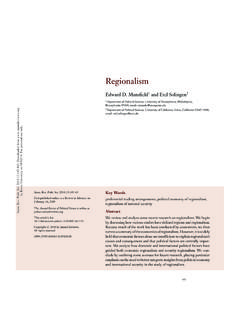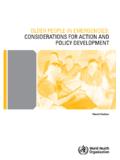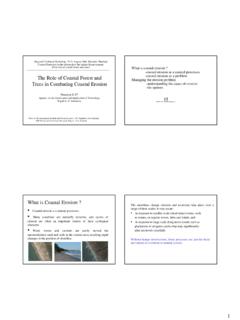Transcription of The Management of Disasters - web.waseda.jp
1 1 The Management of DisastersIntroductionDisasters have adversely affected humans since the dawn of our existence. In response, individuals andsocieties alike have made many attempts to decrease their exposure to the consequences of these dis-asters, developing measures to address initial impact, as well as post- disaster response and recoveryneeds. Regardless of the approach adopted, all of these efforts have the same goal: motivating concepts that guide disaster Management the reduction of harm to life, property,and the environment are largely the same throughout the world. However, the capacity to carry outthis mission is by no means uniform.
2 Whether due to political, cultural, economic, or other reasons,the unfortunate reality is that some countries and some regions are more capable than others at addres-sing the problem. But no nation, regardless of its wealth or influence, is advanced enough to be fullyimmune from Disasters negative effects. Furthermore, the emergence of a global economy makes it moreand more difficult to contain the consequences of any disaster within one country s chapter examines basic concepts of disaster Management and expands upon those conceptsto specifically address the Management of international Disasters . A brief history of disaster manage-ment is provided for context.
3 To illustrate the disparity in the effects of Disasters around the world,an examination of the global impact of Disasters will follow. Finally, several relevant terms usedthroughout this text will be Throughout HistoryDisasters are not merely ornamental or interesting events that adorn our collective historical record these disruptions have served to guide and shape it. Entire civilizations have been decimated in aninstant. Time and time again, epidemics and pandemics have resulted in sizable reductions of theworld s population, as much as 50% across Europe during the fourteenth century bubonic plague(Black Plague) pandemic.
4 Theorists have even ventured to suggest that many of history s great civiliza-tions, including the Mayans, the Norse, the Minoans, and the Old Egyptian Empire, were ultimatelybrought to their knees not by their enemies but by the effects of floods, famines, earthquakes,tsunamis, El Nin o events, and other widespread Disasters (Fagan, 1999).Aworldwide drought inthe eighth and ninth centuries, caused by shifts in the yearly monsoons and resulting in mass cropfailure and subsequent starvation, is now believed to have been behind the fall of both the Mayanempire in Mexico and the Tang dynasty in China (Sheridan, 2007).
5 From a modern perspective, eachof the catastrophic events that has occurred as of late, including the December 26, 2004, earthquake1and tsunami (over 230,000 killed), the 2005 Kashmir earthquake (80,000 killed), the 2008 Sichuanearthquake in China (68,000 killed), and the 2010 Haiti earthquake (perhaps as many as 200,000killed), might seem anomalous, but these disastrous events are not close to record-breaking, or evenunique, in the greater historical context (seeTable 1 1).The History of disaster ManagementAncient HistoryHazards, and the Disasters that often result, have not always existed. To qualify as a hazard, an action,event, or object must maintain a positive likelihood of affecting man or possibly have a consequencethat may adversely affect man s existence.
6 Until humans existed on the planet, neither the likelihoodnor the consequence factors of hazards were calculable; thus their presence is the appearance of man, however, followed the incidence of hazards and Disasters . Archeolo-gical discovery has shown that our prehistoric ancestors faced many of the same risks that exist today:starvation, inhospitable elements, dangerous wildlife, violence at the hands of other humans, disease,accidental injuries, and more. These early inhabitants did not, however, sit idly by and become easy vic-tims. Evidence indicates that they took measures to reduce, ormitigate,their risks.
7 The mere fact thatthey chose to inhabit caves is testament to this applications of disaster Management appear throughout the historical record. The storyof Noah s ark from the Old Testament, for example, is a lesson in the importance of warning, pre-paredness, and mitigation. In this tale, believed to be based at least partly upon actual events, Noahis warned of an approaching flood. He and his family prepare for the impending disaster by construct-ing a floating ark. The protagonist in this story even attempts to mitigate the impact on the planet sbiodiversity by collecting two of each species and placing them within the safety of the ark.
8 These indi-viduals are rewarded for their actions by surviving the disastrous flood. Those who did not performsimilar actions, the story tells us, of risk Management practices can be found as early as 3200 BC. In what is nowmodern-day Iraq lived a social group known as the Asipu. When community members faced a difficultTable 1 1 Selected Notable Disasters Throughout HistoryDisasterYearNumber KilledMediterranean earthquake (Egypt and Syria)12011,100,000 Shaanzi earthquake (China)1556830,000 Calcutta typhoon (India)1737300,000 Caribbean hurricane (Martinique, St. Eustatius, Barbados)178022,000 Tamboro volcano (Indonesia)181580,000 Influenza epidemic (world)191720,000,000 Yangtze River flood (China)19313,000,000 Famine (Russia)19325,000,000 Bangladesh cyclone (Bangladesh)1970300,000 Tangshan earthquake (China)1976655,000 Source:St.
9 Louis University, 1997;NBC News, TO INTERNATIONAL disaster Management decision, especially one involving risk or danger, they could appeal to the Asipu for advice. The Asipu,using a process similar to modern-day hazards risk Management , would first analyze the problem athand, propose several alternatives, and finally give possible outcomes for each alternative (Covello& Mumpower, 1985). Today, this methodology is referred to asdecision analysis,and it is key toany comprehensive risk Management history is also marked by incidents of organized emergency response. For example, whenin AD79 the volcano Vesuvius began erupting, two towns in its shadow Herculaneum andPompeii faced an impending catastrophe.
10 Although Herculaneum, which was at the foot of the vol-cano and therefore directly in the path of its lavaflow, was buried almost immediately, the majorityof Pompeii s population survived. This was because the citizens of Pompeii had several hours beforethe volcano covered their city in ash, and evidence suggests that the city s leaders organized a massevacuation. The few who refused to leave suffered the ultimate consequence, and today lie as RootsAll-hazards disaster and emergency Management , wherein a comprehensive approach is applied toaddress most or all of a community s hazard risks, are relatively new.



